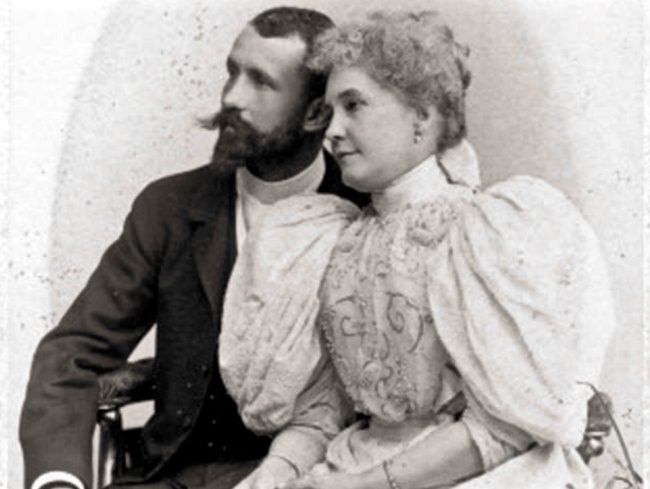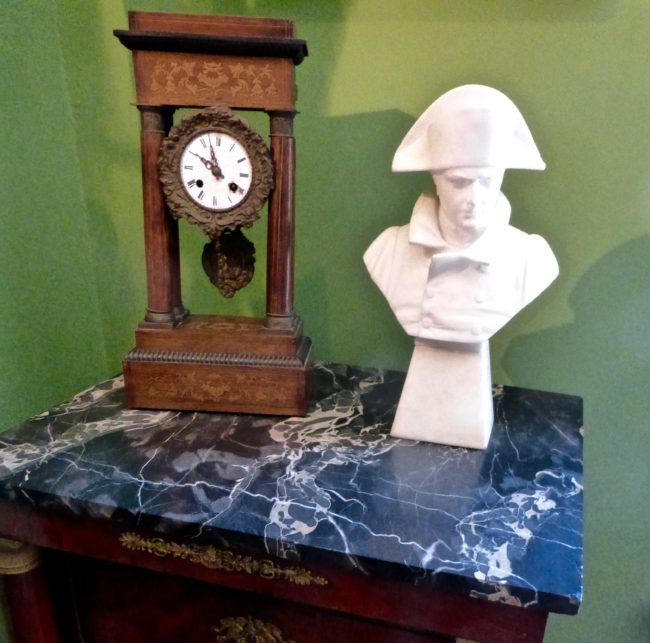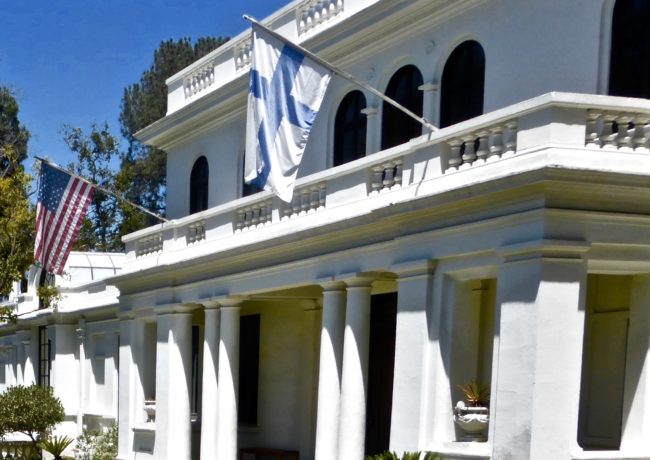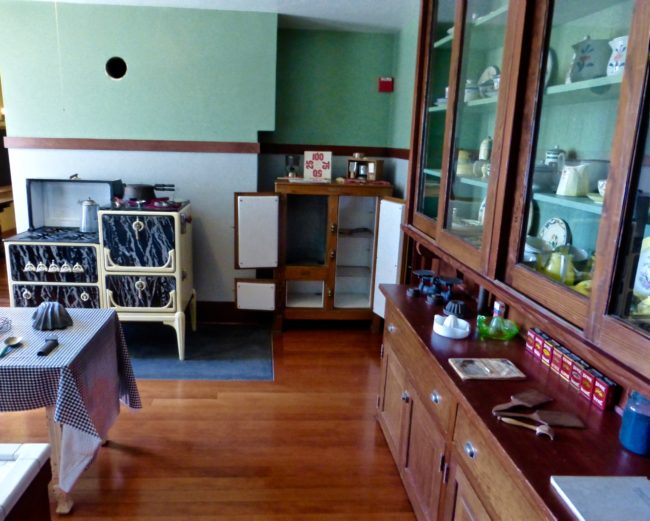
St. Andrew Church – Pasadena
July 14, 2016
Sports Museum of Los Angeles – Los Angeles
August 16, 2016“Downsized” Mansion
 Pasadena Museum of History/Fenyes Mansion – Pasadena
Pasadena Museum of History/Fenyes Mansion – Pasadena
It’s not often that when a family plans to downsize, they decide to build a 21-room Beaux Arts mansion, but that’s exactly what Dr. Adalbert and Eva Fenyes did back in 1906 (well, a few rooms were added in 1911). Recently I took a tour of that historic home; Pasadena’s famed Fenyes Mansion. Not only is the mansion a cool place to visit, but the history of the house (which at one time also served as the Finnish Consulate) and its occupants are equally as interesting.
After my tour, I also “horsed” around a bit at the nearby Pasadena Museum Of History (who maintains the century-old estate and provides these docent-led tours).
Our docent imparted us with some historical knowledge to start. Adalbert Fenyes was a famed Hungarian physician and entomologist (no, the house was not bugged). He was also the first doctor in Pasadena to use an X-Ray machine.
 He met his future wife, Eva (who was an artist) in Cairo, Egypt, where he was practicing medicine and she was studying art (looks like she would walk a mile for a camel). They were married (her second marriage) in Budapest, Hungary, in 1896.
He met his future wife, Eva (who was an artist) in Cairo, Egypt, where he was practicing medicine and she was studying art (looks like she would walk a mile for a camel). They were married (her second marriage) in Budapest, Hungary, in 1896.
It wasn’t too long thereafter that the couple (and a daughter, Leonora, from her first marriage) moved to America’s greatest city (Pasadena) and purchased a Moorish mansion.
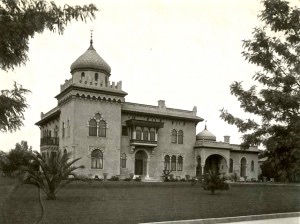 In 1905, they decided the 30-plus room house (which could also be called more-ish) was proving to be a tad bit large, so they commissioned famous architect Robert Farquhar to draw plans for a smaller mansion on the corner of Orange Grove Avenue and Walnut Street (part of Pasadena’s “Millionaire’s Row”). The couple moved into their “second Fenyes Mansion” in 1906 (as an aside, their large Moorish mansion was destroyed by fire in 1915 “under mysterious circumstances”). The new home cost a whopping $20,325.
In 1905, they decided the 30-plus room house (which could also be called more-ish) was proving to be a tad bit large, so they commissioned famous architect Robert Farquhar to draw plans for a smaller mansion on the corner of Orange Grove Avenue and Walnut Street (part of Pasadena’s “Millionaire’s Row”). The couple moved into their “second Fenyes Mansion” in 1906 (as an aside, their large Moorish mansion was destroyed by fire in 1915 “under mysterious circumstances”). The new home cost a whopping $20,325.
 Our docent also explained that some additions to the home in 1911 (a studio, conservatory and laboratory) were made by another famous architect, Sylvanus Marston.
Our docent also explained that some additions to the home in 1911 (a studio, conservatory and laboratory) were made by another famous architect, Sylvanus Marston.
We learned that Eva encouraged film production on the property (the first person in Pasadena to do so). Eva liked to hobnob with famous actors and directors. According to the museum website, “In 1912, D.W. Griffith became the first to use the property as a film location for his period costume drama When Kings Were the Law, starring Mabel Normand and Mae Marsh (re-titled The Necklace).”
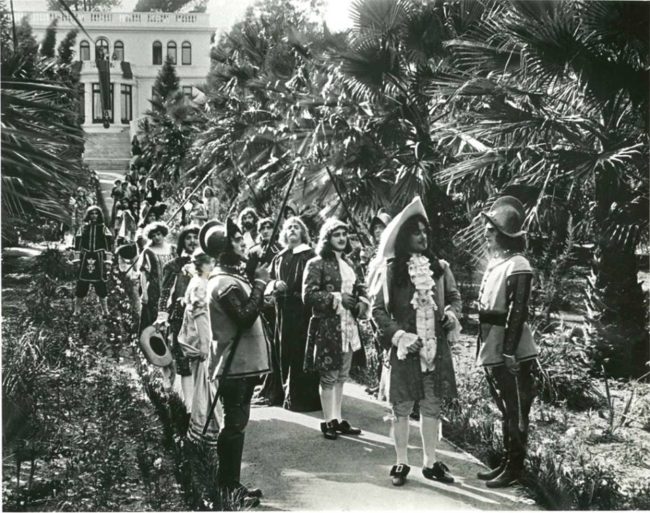 Western Blood, starring cowboy star Tom Mix, was filmed there in 1918, and the property has been used for many films throughout the decades. I assume Eva hosted a gala Mix-er afterward (all the old photos from Pasadena Museum of History).
Western Blood, starring cowboy star Tom Mix, was filmed there in 1918, and the property has been used for many films throughout the decades. I assume Eva hosted a gala Mix-er afterward (all the old photos from Pasadena Museum of History).
 Now it was time to enter the residence, which was good because the temperature outside was hovering around 105 degrees. We donned our “booties” and went in. Walking through the front door we first came to the Entry Hall, which had a beautiful staircase we were not allowed to ascend.
Now it was time to enter the residence, which was good because the temperature outside was hovering around 105 degrees. We donned our “booties” and went in. Walking through the front door we first came to the Entry Hall, which had a beautiful staircase we were not allowed to ascend.
It also had a cool grandfather clock. From the website, it was “featured in the 1904 World’s Fair in St. Louis and then in the veranda of the second Raymond Hotel (in Pasadena). It was saved from a fiery death when it was removed from the Raymond Hotel for repairs.” It was donated to the Pasadena Historical Society in the late 1970s. Sadly, the lighting in that area made a decent picture impossible to take (maybe they’ll let me back in to take one if I ask nicely).
Our next stop was the Reception Area. Eva was an avid world traveler, so there were items from all over the world. Accessing the Reception Area, we passed a couple of hand-carved Spanish oak screens.
Below is a 16th-century Spanish chest made of Gold, Onyx and Ivory. Rumor has it that the secret compartments were used to hide valuables during the Spanish Inquisition. The paintings on the wall are of Eva’s grandparents.
 Adalbert and Eva must have thrown some elegant dinner parties in their Dining Room…
Adalbert and Eva must have thrown some elegant dinner parties in their Dining Room…
 …because the place settings were very attractive.
…because the place settings were very attractive.
 Eva liked to sketch and paint. You will find her watercolors throughout the mansion. I’m not sure if this painting in the dining room of her daughter is by Eva or not.
Eva liked to sketch and paint. You will find her watercolors throughout the mansion. I’m not sure if this painting in the dining room of her daughter is by Eva or not.
According to the website, “Eva had the dining set shipped to Carlenos Nash Company in Los Angeles so that the workmen there could carve a matching fireplace mantle….
 …The set arrived at the workshop in 1906.” On the mantle were some pretty artifacts, including a 19th century Louis XV style clock…
…The set arrived at the workshop in 1906.” On the mantle were some pretty artifacts, including a 19th century Louis XV style clock…
 …and a couple of Sevres-type (from France) lidded Porcelain urns from 1753.
…and a couple of Sevres-type (from France) lidded Porcelain urns from 1753.
 Back in the olden days, people would decorate their own tea cups. These were hand-painted by Eva (they are portraits of Leonora and her friends).
Back in the olden days, people would decorate their own tea cups. These were hand-painted by Eva (they are portraits of Leonora and her friends).
 It was time to head down the hall.
It was time to head down the hall.
 On the right was the small bedroom that Eva used. The couple slept in separate bedrooms (I didn’t show this to Tracy fearing she might get some ideas). As you can see, Eva was quite a fan of Napoléon.
On the right was the small bedroom that Eva used. The couple slept in separate bedrooms (I didn’t show this to Tracy fearing she might get some ideas). As you can see, Eva was quite a fan of Napoléon.
The mahogany sleigh bed is in a Napoleonic design (I guess that’s why it’s so small). The linen? Why they’re French, bien sûr.
 There are two important paintings in this room. One, California Poppies, was painted by Benjamin Brown, a well-known California impressionist landscape artist.
There are two important paintings in this room. One, California Poppies, was painted by Benjamin Brown, a well-known California impressionist landscape artist.
 The other, Dappled Light, a picture of the Fenyes Garden, is an impressionistic painting by Richard Miller, who was another American Impressionist painter and member of the Giverny Colony of American Impressionists.
The other, Dappled Light, a picture of the Fenyes Garden, is an impressionistic painting by Richard Miller, who was another American Impressionist painter and member of the Giverny Colony of American Impressionists.
It seemed the only impressionist not in the room was Rich Little.
 Not quite having full faith in the reliability of electricity, which had come to Pasadena in 1887, Eva had both an electric light and a wick she could light…just in case.
Not quite having full faith in the reliability of electricity, which had come to Pasadena in 1887, Eva had both an electric light and a wick she could light…just in case.
 Across the hall was Adalbert’s small bedroom (now an office).
Across the hall was Adalbert’s small bedroom (now an office).
 Since he slept alone, he had lots of time to ponder about his passion; beetles.
Since he slept alone, he had lots of time to ponder about his passion; beetles.
From the Pasadena Museum Of History website, ”Dr. Adalbert Fenyes is shown here in his ‘Insectorium’ in the gardens of the Fenyes Mansion. In addition to being a practicing physician, Dr. Fenyes was also a renowned entomologist. He traveled the world collecting beetle specimens. Today this important beetle collection is housed at the California Academy of Sciences in San Francisco.”
 On one trip to Mexico, Dr. Fenyes brought back 10,000 new beetles to add to his collection (thankfully no TSA at that time to contend with). And to think my Beatle collection only contains a bunch of old albums.
On one trip to Mexico, Dr. Fenyes brought back 10,000 new beetles to add to his collection (thankfully no TSA at that time to contend with). And to think my Beatle collection only contains a bunch of old albums.
 In 1946, his granddaughter married Y. A. Paloheimo of Finland, who was appointed Finnish Consul for Southern California the following year. This house became the area’s first Finnish Consul, and stayed that until 1965. Adalbert’s former bedroom became the consulate. This insignia used to hang on the front gate.
In 1946, his granddaughter married Y. A. Paloheimo of Finland, who was appointed Finnish Consul for Southern California the following year. This house became the area’s first Finnish Consul, and stayed that until 1965. Adalbert’s former bedroom became the consulate. This insignia used to hang on the front gate.
A 1947 remodel of Adalbert’s bedroom transformed it into an office and study for Consul Paloheimo. This is the room where he received dignitaries and diplomats. The black and white photo is of his friend, Finnish composer Jean Sibelius.
 Next we headed to the the Drawing Room, complete with Louis XV furniture…
Next we headed to the the Drawing Room, complete with Louis XV furniture…
…a Steinway piano…
 …and a late 19th or early 20th century Italian Baroque style lamp. Luckily they didn’t go baroque purchasing it.
…and a late 19th or early 20th century Italian Baroque style lamp. Luckily they didn’t go baroque purchasing it.
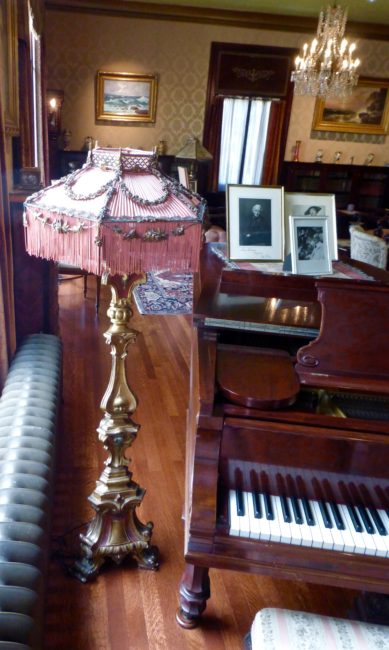 The Solarium was also a 1911 addition to the home and was used as a greenhouse.
The Solarium was also a 1911 addition to the home and was used as a greenhouse.
Then came the coolest room in the house. Our docent called it a “Music Room, a Salon, A Studio and a Concert Hall.”
 It contained a Minstrel’s Gallery where musicians were invited to perform.
It contained a Minstrel’s Gallery where musicians were invited to perform.
 The fireplace was made in Pasadena, and Dr. Fenyes’ coat of arms is represented in the mantel.
The fireplace was made in Pasadena, and Dr. Fenyes’ coat of arms is represented in the mantel.
 It had a beautiful chest flanked by two chairs.
It had a beautiful chest flanked by two chairs.
 Musical instruments included an 1883 Weber piano (I don’t believe you can barbecue on one of these, however)…
Musical instruments included an 1883 Weber piano (I don’t believe you can barbecue on one of these, however)…
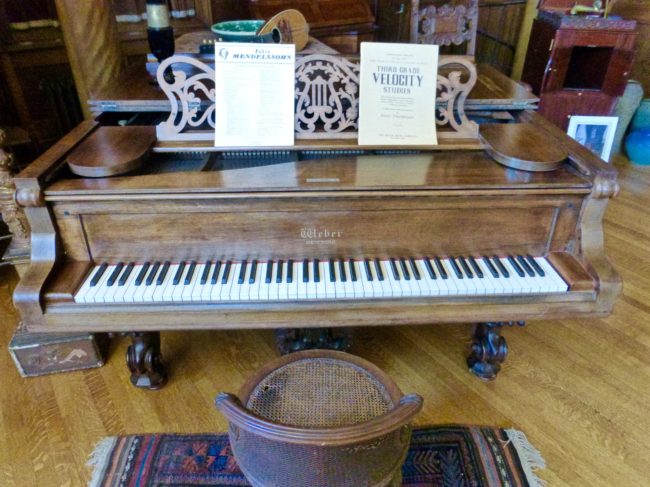 …a late 19th or early 20th century mandolin that Eva actually played (a woman of many talents).
…a late 19th or early 20th century mandolin that Eva actually played (a woman of many talents).
 …and a 1908 Victor Victrola (wasn’t that a Julie Andrews/James Garner movie).
…and a 1908 Victor Victrola (wasn’t that a Julie Andrews/James Garner movie).
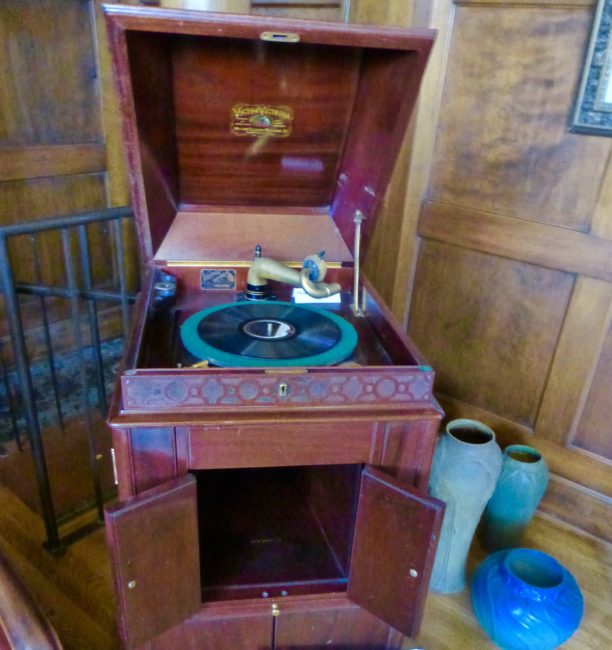 This room even contained the cage where the family’s pet marmoset, Dom Pedro de Jura Juba, lived. Hey, I don’t monkey around with these reports.
This room even contained the cage where the family’s pet marmoset, Dom Pedro de Jura Juba, lived. Hey, I don’t monkey around with these reports.
 Before leaving we saw many paintings including the “Portrait of a Cardinal,” an 1880s painting by William Satterle.
Before leaving we saw many paintings including the “Portrait of a Cardinal,” an 1880s painting by William Satterle.
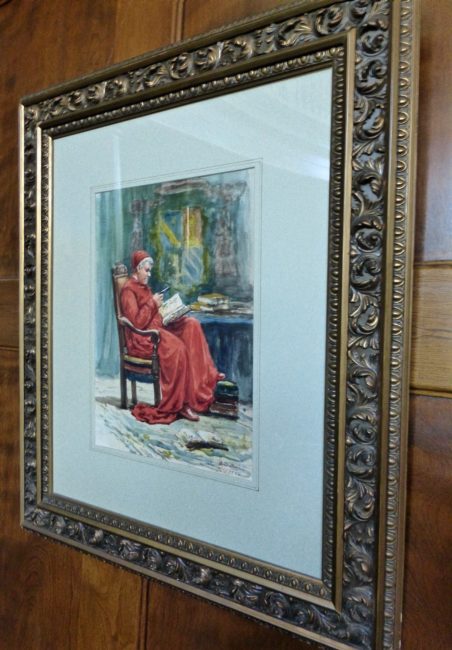 The owl didn’t seem to give a hoot about anything, so we pressed on.
The owl didn’t seem to give a hoot about anything, so we pressed on.
 The final room we entered was the Kitchen…
The final room we entered was the Kitchen…
…complete with a 1921 stove…
…and two toasters from 1911.
 Before leaving we peaked around at the old Boiler that had been brought up from the basement. Don’t be too “cocksure” when following the directions.
Before leaving we peaked around at the old Boiler that had been brought up from the basement. Don’t be too “cocksure” when following the directions.
Speaking of boiling, we walked out in front of the house…
…and luckily made it to a shady area before we melted. The architectural firm of Marston & Van Pelt, who designed the additions in 1911, also designed the 1915 Curtin House, the French-influenced house constructed for Leonora Curtin. Eva had it built for her daughter and granddaughter after Leonora’s husband died at an early age.
 Eva passed away in 1930, and Adalbert remarried. He died in 1937. In 1965, the property was vacated, and in 1970 the Paloheimo Foundation put the estate under the management of the Pasadena Historical Society, which today owns all the contents of the land and structures.
Eva passed away in 1930, and Adalbert remarried. He died in 1937. In 1965, the property was vacated, and in 1970 the Paloheimo Foundation put the estate under the management of the Pasadena Historical Society, which today owns all the contents of the land and structures.
Further on, past the garden area…
… we came upon The Finnish Folk Art Museum. “Furnished in the style of a 19th century Finnish farmhouse, this unique exhibition provides a fascinating glimpse into Finland’s tradition and culture and reminds visitors that the Fenyes Mansion once served as the Finnish Consulate. It was started in 1974 by the Paloheimos and is is the only exhibit of its kind outside of Finland.”
The front room is a “recreated smoke cabin, found in 19th-Century Finland. Among the objects on view are a cradle, spinning wheel and butter churn, all made of wood, and a brick hearth… It was originally built as a garage to a since-demolished house, is a 1910 Swiss chalet-styled building which was moved to the property in 1949.”
 Sadly it wasn’t open due to an event, so in reality, I really didn’t get to Finnish the tour.
Sadly it wasn’t open due to an event, so in reality, I really didn’t get to Finnish the tour.
Before we had started, and the temperature hadn’t quite hit 100…
 …I took a few exterior photos of the exterior of the Fenyes Mansion and its gardens with a number of large trees.
…I took a few exterior photos of the exterior of the Fenyes Mansion and its gardens with a number of large trees.
With the tour now complete, I could have departed and been satisfied, but while waiting for the tour to begin I had read about a special exhibition that the Pasadena Museum of History was showcasing…plus it was air-conditioned inside, and my camera was melting.
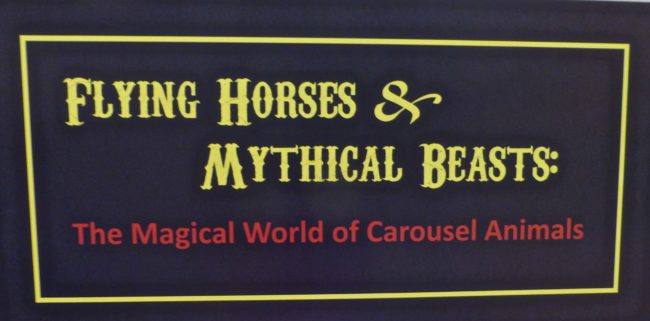 “Flying Horses & Mythical Beasts…The Magical World Of The Carousel” filled a couple of the rooms indoors, making it the museum’s Mane event.
“Flying Horses & Mythical Beasts…The Magical World Of The Carousel” filled a couple of the rooms indoors, making it the museum’s Mane event.
 I hoofed it between the two rooms viewing pieces from the “Golden Age of Carousels, 1861-1920” and more.
I hoofed it between the two rooms viewing pieces from the “Golden Age of Carousels, 1861-1920” and more.
 A company called Running Horse Studio restores carousel and merry-go-round animals. From its website, “Running Horse Studio
A company called Running Horse Studio restores carousel and merry-go-round animals. From its website, “Running Horse Studio
began it’s journey with one Dentzel mule in the early 1980’s. It has burgeoned into one of the world’s largest collections.” I found the fact that the studio started out with a mule very interesting. Why, you ask…because the owner’s name is Lourinda Bray. Coincidence, I think not.
There was some literature on each of the horses, or as I called them, “Pony Tales.” I enjoyed the horses, although I didn’t stay furlong.
Some of my favorites included a 1916 horse that was ridden at the Santa Monica Pier’s Hippodrome and Belmont Park in San Diego.
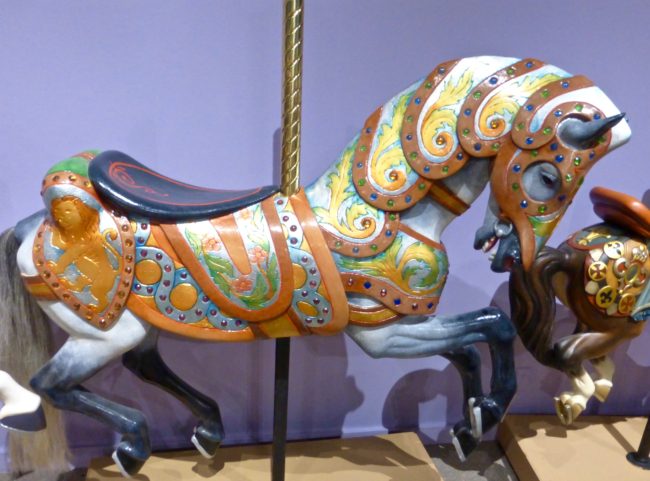 …and a horse from the Philadelphia Tobaggan Company; circa 1920. I looked at it for a bit.
…and a horse from the Philadelphia Tobaggan Company; circa 1920. I looked at it for a bit.
 This one is a 1910 model last used in Missouri in the 1920s.
This one is a 1910 model last used in Missouri in the 1920s.
 I ran into my old friend Woody Woodpecker, who was carved (perhaps the resourceful woodpecker carved it himself) about 1940 in Mexico. When Bray got him, he was missing his tail among other things. She painstakingly restored Woody back to life (“uh huh huh ha huh huh huh huh ha huh huh huh huh ha huh”).
I ran into my old friend Woody Woodpecker, who was carved (perhaps the resourceful woodpecker carved it himself) about 1940 in Mexico. When Bray got him, he was missing his tail among other things. She painstakingly restored Woody back to life (“uh huh huh ha huh huh huh huh ha huh huh huh huh ha huh”).
 Finally, these two carousel ladies, also carved in Mexico, from 1940 caught my eye.
Finally, these two carousel ladies, also carved in Mexico, from 1940 caught my eye.
 This colorful and surprisingly fascinating exhibition, one of many that rotates (of course, a carousel exhibition should rotate) through the museum during the year, runs until August 28th.
This colorful and surprisingly fascinating exhibition, one of many that rotates (of course, a carousel exhibition should rotate) through the museum during the year, runs until August 28th.
 The Fenyes Mansion docent-led tours are held at 12:15 p.m. on Friday, Saturday and Sunday.
The Fenyes Mansion docent-led tours are held at 12:15 p.m. on Friday, Saturday and Sunday.
 I’ve always been interested in old houses and some tours are better than others. This one held my interest throughout, and it took a little more than 90 minutes. My only regret was that we didn’t tour the rooms upstairs. Orange Grove Avenue’s “Millionaire’s Row” used to have some of the most beautiful mansions you would ever want to see. Sadly, in the 20th-century many of these grand old homes were torn down to make room for giant condominiums, which is a travesty. Fortunately, you still have the Fenyes Mansion and nearby Gamble House where you can take tours to view the beautiful architecture of those residences. Both are well worth your time.
I’ve always been interested in old houses and some tours are better than others. This one held my interest throughout, and it took a little more than 90 minutes. My only regret was that we didn’t tour the rooms upstairs. Orange Grove Avenue’s “Millionaire’s Row” used to have some of the most beautiful mansions you would ever want to see. Sadly, in the 20th-century many of these grand old homes were torn down to make room for giant condominiums, which is a travesty. Fortunately, you still have the Fenyes Mansion and nearby Gamble House where you can take tours to view the beautiful architecture of those residences. Both are well worth your time.
Pasadena Museum of History
470 West Walnut Street
Pasadena, CA 91103
Phone: 626.577.1660
Hours: Wednesday – Sunday from noon to 5 p.m.
Admission: $7 (children under 12 are free)
pasadenahistory.org
Fenyes Mansion Tours
Docent-led tours Friday, Saturday and Sunday at 12:15
Ticket price: $15
http://pasadenahistory.org/fenyes-mansion-tours/
Purchase tickets: http://fenyesmansion.bpt.me/
Parking: Lot and street parking: Free






